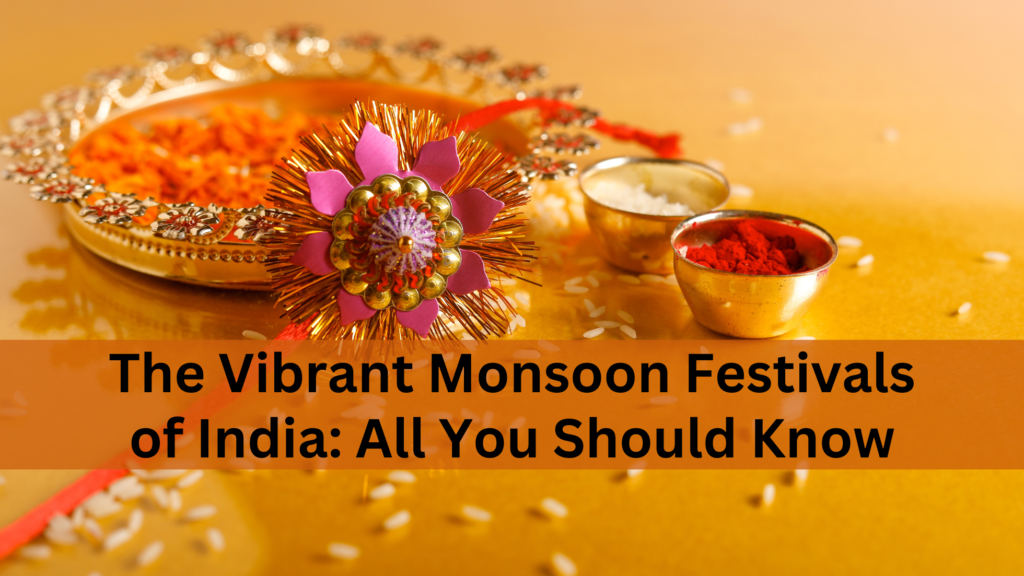Introduction: The Spiritual and Cultural Significance of Monsoon Festivals in India
Monsoon in India is more than just a season;. It’s a time when nature comes alive, rejuvenating the earth after the scorching summer. This period of renewal and abundance is celebrated with a series of festivals across the country. Each rich in cultural and spiritual significance. These festivals not only honor the natural bounty that the rains bring but also strengthen communal bonds and traditions that have been passed down through generations. This article delves into the most iconic monsoon festivals in India. Exploring their ancient roots, spiritual meanings, and the joyous celebrations that accompany them.
Teej: The Festival of Swings and Sisterhood
Teej, predominantly celebrated in Rajasthan, Haryana, and Punjab, is one of the most significant festivals of the monsoon season. Dedicated to Goddess Parvati, Teej symbolizes the union of Parvati with Lord Shiva. Embodying the themes of marital bliss and the sanctity of marriage. The festival is characterized by women swinging on beautifully adorned swings, dressed in vibrant green attire that symbolizes fertility and life.
Historically, Teej was a time for women to retreat from their daily chores and indulge in a celebration of sisterhood. The practice of fasting, singing traditional songs, and applying intricate henna designs are integral to the festival. This fosters a sense of community among women. The festival’s rituals are deeply spiritual, reflecting the deep-rooted belief in the divine feminine and the cycles of nature. The lush green landscape, accentuated by the monsoon rains. Which adds to the festive atmosphere, making Teej a visually and spiritually uplifting experience.
Onam: Kerala’s Harvest Extravaganza
Onam, the grand harvest festival of Kerala, is a ten-day-long celebration. That marks the homecoming of the mythical King Mahabali. Under whose reign Kerala is believed to have witnessed its golden age. The festival. Which usually falls during the monsoon season, is a reflection of Kerala’s rich agricultural heritage and its deep spiritual roots.
The highlight of Onam is the grand feast known as Onam Sadhya, served on banana leaves. It features an array of dishes that showcase the region’s culinary diversity. The festival is also famous for its pookalams, intricate flower carpets that adorn homes and public spaces. Which symbolizes the vibrancy and abundance of the monsoon. The traditional boat races, known as Vallam Kali. These are a spectacle of communal unity and competitive spirit, drawing spectators from across the world.
Onam is not just a festival; it is a cultural extravaganza that embodies the spirit of Kerala. The monsoon rains, which rejuvenate the land, add a mystical charm to the festivities, making Onam a truly enchanting experience that connects people with their heritage and the cycles of nature.
Nag Panchami: The Serpent Festival
Nag Panchami, celebrated during the monsoon season, is a unique festival dedicated to the worship of snakes. Which are revered in Hindu mythology as protectors of the earth’s treasures. Celebrated across various parts of India, including Maharashtra, Karnataka, and Bengal, Nag Panchami. It highlights the ancient Indian belief in the symbiotic relationship between humans and nature.
Devotees offer milk, honey, and flowers to snake idols. And in some cases, live snakes, seeking protection from snake bites and blessings for prosperity. The festival is deeply rooted in spirituality, as snakes are considered to be the embodiments of Kundalini. A primal energy believed to reside at the base of the spine. The monsoon season, which often brings snakes out of their burrows. Which underscores the significance of this festival as a time to honor and appease these powerful creatures.
Janmashtami: Celebrating Krishna’s Birth
Janmashtami, the celebration of Lord Krishna’s birth. It is one of the most beloved festivals in India, marked by joyous celebrations. Especially in regions like Uttar Pradesh, Gujarat, and Maharashtra. The festival, which usually falls during the monsoon, is a vibrant expression of devotion and love for Krishna, who is considered the embodiment of divine joy and love.
The spiritual significance of Janmashtami lies in the celebration of Krishna’s birth, which symbolizes the victory of good over evil. Devotees observe fasting, engage in night-long prayers, and participate in dramatic enactments of Krishna’s life, known as Ras Leela. In Maharashtra, the Dahi Handi event, is a team spirit event. Where teams form human pyramids to break a pot filled with curd, is a highlight of the festivities. The monsoon rains add to the excitement. Which turns the event into a thrilling spectacle that reflects the playful and mischievous nature of Krishna.
Raksha Bandhan: The Bond of Protection
Raksha Bandhan, celebrated during the monsoon, is a festival that honors the sacred bond between brothers and sisters. The festival, which is observed across India. It involves sisters tying a rakhi, a sacred thread, around their brothers’ wrists, symbolizing their love and prayers for their brothers’ well-being. In return, brothers vow to protect their sisters from harm.
The spiritual essence of Raksha Bandhan lies in the concept of protection and duty. This reflects the deep-seated values of family and loyalty. The festival, which is accompanied by the exchange of gifts and sweets, brings families together. This fosters a sense of unity and love. The monsoon season, with its cooling rains, adds a nostalgic and comforting atmosphere to the celebrations. This makes Raksha Bandhan a cherished occasion for families to connect and strengthen their bonds.

Ganesh Chaturthi: Welcoming the Elephant God
Ganesh Chaturthi, celebrated predominantly in Maharashtra, Karnataka, and Andhra Pradesh. It marks the birth of Lord Ganesha. The god of beginnings and the remover of obstacles. The festival, which lasts for ten days. It is marked by the installation of elaborately crafted Ganesha idols. In homes and public pandals, where devotees offer prayers and seek blessings for prosperity and success.
The festival’s spiritual significance lies in the worship of Ganesha, who is revered as the deity of wisdom and intelligence. The monsoon rains add to the grandeur of the festival. With colorful processions and the eventual immersion of the Ganesha idols in water bodies. It symbolizes the cycle of creation and dissolution. The communal aspect of Ganesh Chaturthi, where people from all walks of life come together to celebrate. This festival reflects the inclusive and joyous spirit of the festival.
Gathemangal: Newari Festival of Kathmandu Valley
Gathemangal – also known as Ghantakarna. It is a unique festival celebrated by the Newar community in the Kathmandu Valley. We often experience monsoon rains during the festival. The festival commemorates the defeat of the demon Ghantakarna by the villagers, symbolizing the triumph of good over evil.
The festival is marked by the construction of effigies of the demon. Which are paraded through the streets and burnt at the end of the day. The monsoon rains, which often accompany the festival. Add a dramatic element to the fiery celebrations, making Gathemangal a visually stunning and spiritually significant event.
Conclusion: Embracing the Monsoon Spirit through Festivals
Monsoon festivals in India are a vibrant celebration of nature, culture, and spirituality. These festivals, each with its unique customs and rituals. They reflect the deep connection between the Indian people and the natural world. The colorful swings of Teej to the grand feasts of Onam. And the protective rituals of Nag Panchami to the joyful bond of Raksha Bandhan. Festivals not only celebrate the rains but also reinforce the values of community, family, and spirituality. As the monsoon rains rejuvenate the earth. These festivals rejuvenate the spirit, reminding us of the timeless traditions that continue to thrive in the heart of India.
Keep Smiling & Be Graced!!
Facebook | Instagram | YouTube | Goodreads | Artwork | Books | Journals – Diaries – Notebooks | Author Central Page | LinkedIn
For collaboration, workshops, wish to come as a guest at my podcast (the healing tree, or wish to get your book published please hit an email – spiritedblogger707@gmail.com
